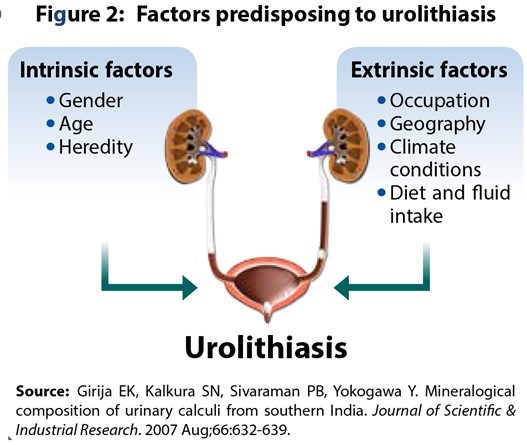A nurse is contributing to the plan of care for a client who has urolithiasis. Which of the following interventions should the nurse include in the plan?
Tell the client to expect a decrease in urine output.
Encourage the client to drink 3 L of fluids per day.
Provide the client with a high protein diet.
Maintain the client on bed rest.
The Correct Answer is B
Choice A Reason: Telling the client to expect a decrease in urine output is not an appropriate intervention for a client who has urolithiasis, as it may indicate dehydration, obstruction, or infection.
Choice B Reason: Encouraging the client to drink 3 L of fluids per day is an appropriate intervention for a client who has urolithiasis, as it helps to flush out stones, prevent new stone formation, and reduce urinary concentration.
Choice C Reason: Providing the client with a high protein diet is not an appropriate intervention for a client who has urolithiasis, as it may increase uric acid and calcium excretion and promote stone formation.
Choice D Reason: Maintaining the client on bed rest is not an appropriate intervention for a client who has urolithiasis, as it may decrease renal perfusion and increase urinary stasis.

Nursing Test Bank
Naxlex Comprehensive Predictor Exams
Related Questions
Correct Answer is A
Explanation
Choice A Reason: Contacting the health care provider is the first nursing action that the nurse should perform, as it indicates that the client may have compartment syndrome, which is a medical emergency that requires immediate intervention to prevent tissue necrosis and nerve damage.
Choice B Reason: Administering PRN pain medication is not the first nursing action that the nurse should perform, as it may not relieve the pain and may mask the symptoms of compartment syndrome.
Choice C Reason: Documenting the findings is not the first nursing action that the nurse should perform, as it may delay the treatment and worsen the outcome of compartment syndrome.
Choice D Reason: Elevating the extremity is not the first nursing action that the nurse should perform, as it may decrease blood flow and increase tissue ischemia in compartment syndrome.
Correct Answer is D
Explanation
Choice A Reason: Hypertension is not a common finding in a client with low calcium level, but it may indicate other conditions such as renal disease or pheochromocytoma.
Choice B Reason: Diaphoresis is not a common finding in a client with low calcium level, but it may indicate other conditions such as fever, anxiety, or hyperthyroidism.
Choice C Reason: Increased thirst is not a common finding in a client with low calcium level, but it may indicate other conditions such as diabetes mellitus, dehydration, or psychogenic polydipsia.
Choice D Reason: Muscle tetany is a common finding in a client with low calcium level, as it indicates that the nerves and muscles are overexcited and contract involuntarily. It may manifest as spasms, cramps, twitching, or tingling sensations.
Whether you are a student looking to ace your exams or a practicing nurse seeking to enhance your expertise , our nursing education contents will empower you with the confidence and competence to make a difference in the lives of patients and become a respected leader in the healthcare field.
Visit Naxlex, invest in your future and unlock endless possibilities with our unparalleled nursing education contents today
Report Wrong Answer on the Current Question
Do you disagree with the answer? If yes, what is your expected answer? Explain.
Kindly be descriptive with the issue you are facing.
